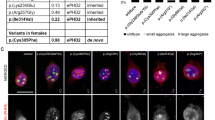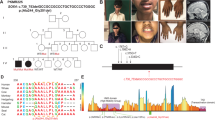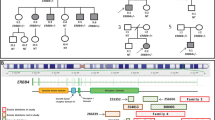Abstract
Nonsyndromic X-linked mental retardation (MRX) syndromes are clinically homogeneous but genetically heterogeneous disorders, whose genetic bases are largely unknown. Affected individuals in a multiplex pedigree with MRX (MRX30), previously mapped to Xq22, show a point mutation in the PAK3 (p21-activated kinase) gene, which encodes a serine-threonine kinase. PAK proteins are crucial effectors linking Rho GTPases to cytoskeletal reorganization and to nuclear signalling. The mutation produces premature termination, disrupting kinase function. MRI analysis showed no gross defects in brain development. Immunofluorescence analysis showed that PAK3 protein is highly expressed in postmitotic neurons of the developing and postnatal cerebral cortex and hippocampus. Signal transduction through Rho GTPases and PAK3 may be critical for human cognitive function.
This is a preview of subscription content, access via your institution
Access options
Subscribe to this journal
Receive 12 print issues and online access
$209.00 per year
only $17.42 per issue
Buy this article
- Purchase on Springer Link
- Instant access to full article PDF
Prices may be subject to local taxes which are calculated during checkout





Similar content being viewed by others
References
Gleeson, J.G. et al. doublecortin, a brain-specific gene mutated in human X-linked lissencephaly and double cortex syndrome, encodes a putative signaling protein. Cell 92, 63–72 (1998).
Antonarakis, S. & Van Aelst, L. Mind the GAP, Rho, Rab and GDI. Nature Genet. 19, 106– 108 (1998).
Gedeon, A., Donnelly, A., Mulley, J., Kerr, B. & Turner, G. How many X-linked genes for nonspecific mental retardation (MRX) are there? Am. J. Med. Genet. 64, 158–162 (1996).
D'Adamo, P. et al. Mutations in GDI1 are responsible for X-linked non-specific mental retardation. Nature Genet. 19, 134 –139 (1998).
Gecz, J., Gedeon, A., Sutherland, G. & Mulley, J. Identification of the gene, FMR2, associated with FRAXE mental retardation. Nature Genet. 13, 105– 108 (1996).
Nobes, C. & Hall, A. Rho, Rac, and Cdc42 GTPases regulate the assembly of multimolecular focal complexes associated with actin stress fibers, lamellipodia, and filopodia. Cell 81, 53–62 (1995).
Kaufmann, N., Wills, Z.P. & Van Vactor, D. Drosophila Rac1 controls motor axon guidance. Development 125, 453–461 (1998).
Luo, L., Liao, Y., Jan, L. & Jan, Y. Distinct morphogenetic roles of similar small GTPases: Drosophila Drac1 is involved in axonal outgrowth and myoblast fusion. Genes Dev. 8, 1787– 1802 (1994).
Luo, L., Jan, L. & Jan, Y. Rho family small GTP-binding proteins in growth cone signalling. Curr. Opin. Neurobiol. 7, 81–86 (1997).
Zipkin, I., Kindt, R. & Kenyon, C. Role of a new rho family member in cell migration and axon guidance in C. elegans. Cell 90, 883 –894 (1997).
Threadgill, R., Bobb, K. & Ghosh, A. Regulation of dendritic growth and remodeling by Rho, Rac, and Cdc42. Neuron 19, 625–634 ( 1997).
Luo, L. et al. Differential effects of the Rac GTPase on Purkinje cell axons and dendritic trunks and spines. Nature 379, 837–840 (1996).
Allen, K., Gleeson, J., Shoup, S. & Walsh, C. A YAC contig in Xq22.3-q23, from DXS287 to DXS8088, spanning the brain-specific genes doublecortin and PAK3. Genomics, in press.
Bagrodia, S., Taylor, S.J., Creasy, C.L., Chernoff, J. & Cerione, R.A. Identification of a mouse p21Cdc42/Rac activated kinase. J. Biol. Chem. 270, 22731 –22737 (1995).
Manser, E. et al. Molecular cloning of a new member of the p21-Cdc42/Rac-activated kinase (PAK) family. J. Biol. Chem. 270, 25070–25078 (1995).
Ogilvie, D.J. & James, L.A. End rescue from YACs using the vectorette. Methods Mol. Biol. 54, 131– 138 (1996).
Donnelly, A.J., Partington, M.W., Ryan, A.K. & Mulley, J.C. Regional localisation of two non-specific X-linked mental retardation genes (MRX30 and MRX31). Am. J. Med. Genet. 64, 113–120 (1996).
Bokoch, G.M. et al. Interaction of the Nck adapter protein with p21-activated kinase (PAK1). J. Biol. Chem. 271, 25746 –25749 (1996).
Hanks, S.K. & Quinn, A.M. Protein kinase catalytic domain sequence database: identification of conserved features of primary structure and classification of family members. Methods Enzymol. 200, 38–62 (1991).
Sells, M.A. et al. Human p21-activated kinase (Pak1) regulates actin organization in mammalian cells. Curr. Biol. 7, 202– 210 (1997).
Gregg, R.G., Palmer, C., Kirkpatrick, S. & Simantel, A. Localization of a non-specific X-linked mental retardation gene, MRX23, to Xq23-q24. Hum. Mol. Genet. 5, 411– 414 (1996).
Gu, X.X. et al. Localisation of a new gene for non-specific mental retardation to Xq22-q26 (MRX35). J. Med. Genet. 33, 52–55 (1996).
Ryan, S.G. et al. Epilepsy and mental retardation limited to females: an X-linked dominant disorder with male sparing. Nature Genet. 17, 92–95 (1997).
Illarioshkin, S.N. et al. X-linked nonprogressive congenital cerebellar hypoplasia: clinical description and mapping to chromosome Xq. Ann. Neurol. 40, 75–83 ( 1996).
Billuart, P. et al. Oligophrenin-1 encodes a rhoGAP protein involved in X-linked mental retardation. Nature 392, 923– 926 (1998).
Bagrodia, S., Derijard, B., Davis, R.J. & Cerione, R.A. Cdc42 and PAK-mediated signaling leads to Jun kinase and p38 mitogen-activated protein kinase activation. J. Biol. Chem. 270, 27995–27998 (1995).
Fischer, M., Kaech, S., Knutti, D. & Matus, A. Rapid actin-based plasticity in dendritic spines. Neuron 20, 847–854 (1998).
Zhang, S. et al. Rho family GTPases regulate p38 mitogen-activated protein kinase through the downstream mediator Pak1. J. Biol. Chem. 270, 23934–23936 (1995).
Brown, J. et al. Human Ste20 homologue hPAK1 links GTPases to the JNK MAP kinase pathway. Curr. Biol. 6, 598– 605 (1996).
Milner, B., Squire, L.R. & Kandel, E.R. Cognitive neuroscience and the study of memory. Neuron 20, 445–468 ( 1998).
Osada, S., Izawa, M., Koyama, T., Hirai, S. & Ohno, S. A domain containing the Cdc42/Rac interactive binding (CRIB) region of p65PAK inhibits transcriptional activation and cell transformation mediated by the Ras-Rac pathway. FEBS Lett. 404, 227– 233 (1997).
Daniels, R.H., Hall, P.S. & Bokoch, G.M. Membrane targeting of p21-activated kinase 1 (PAK1) induces neurite outgrowth from PC12 cells. EMBO J. 17, 754–764 (1998).
Galisteo, M.L., Chernoff, J., Su, Y.C., Skolnik, E.Y. & Schlessinger, J. The adaptor protein Nck links receptor tyrosine kinases with the serine- threonine kinase Pak1. J. Biol. Chem. 271, 20997–21000 (1996).
Lu, W., Katz, S., Gupta, R. & Mayer, B. Activation of Pak by membrane localization mediated by an SH3 domain from the adaptor protein Nck. Curr. Biol. 7, 85– 94 (1997).
Manser, E. et al. Expression of constitutively active α-PAK reveals effects of the kinase on actin and focal complexes. Mol. Cell Biol. 17, 1129–1143 (1997).
Murphy, T., Schnaar, R. & Coyle, J. Immature cortical neurons are uniquely sensitive to glutamate toxicity by inhibition of cystine uptake. FASEB J. 4, 1624–1633 (1990).
Acknowledgements
We are grateful to the patients who participated in this study. We thank the following individuals for providing DNA samples from pedigrees that ultimately did not show PAK3 mutations: S. Illarioshkin, S. Claes, S. Fritz, J.-J. Cassiman, S. Ryan and R. Gregg. We thank J. Gonzalez, E. Olsen and S. de la Calle for help with immunohistochemistry, Y. Feng and F. Watson for help with COS cell transfection and western blots, J. Fox for help with SSCP, T. Young-Poussaint for reviewing the MRI and S. Hong for technical assistance. K.M.A. was supported by an NRSA from the NIMH (MH10691) and by the Goldenson/Berenberg fellowship. J.G.G. was supported by an NSADA from the NINDS (5K12NS01701) and by an educational grant from Sigma Tau Pharmaceuticals. C.A.W. was supported by the Human Frontier Science Program and NIH RO1 NS 35129 from the NINDS. C.A.W. is a Scholar of the Rita Allen Foundation.
Author information
Authors and Affiliations
Corresponding author
Rights and permissions
About this article
Cite this article
Allen, K., Gleeson, J., Bagrodia, S. et al. PAK3 mutation in nonsyndromic X-linked mental retardation. Nat Genet 20, 25–30 (1998). https://doi.org/10.1038/1675
Received:
Accepted:
Issue Date:
DOI: https://doi.org/10.1038/1675



